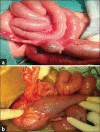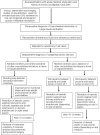Congenital Colonic Stenosis: A Rare Gastrointestinal Malformation in Children
- PMID: 34728917
- PMCID: PMC8515529
- DOI: 10.4103/jiaps.JIAPS_180_20
Congenital Colonic Stenosis: A Rare Gastrointestinal Malformation in Children
Abstract
Aims: Congenital colonic stenosis (CCS) is an extremely rare cause of low-intestinal obstruction in neonates/child. We report our experience with seven cases of CCS presenting with low-intestinal obstruction and diagnosed intraoperatively and also propose an algorithm for its appropriate treatment for the adequate outcome.
Materials and methods: It was a retrospective study of seven patients of CCS including two neonates (5-days and 15-days old), four infants (age range - 2-11 months), and one 24-month-old child admitted from 2014 to 2019. Information regarding the age of presentation, clinical presentation, physical findings, radiological and laboratory findings, details of surgery, and outcome was retrieved and analyzed.
Results: The male-to-female ratio was 5:2. Patients were initially diagnosed as cases of Hirschsprung's disease in five and ileal atresia in two. A final diagnosis of CCS was made during surgery and histopathological examination of resected stenotic segment. The segment involved was ascending colon in three, transverse colon in two, and sigmoid colon and junction of descending and sigmoid colon each in one patient. Resection of stenotic colonic segment and primary end-to-end anastomosis was performed in two, divided stoma after resection of the stenotic segment and secondary anastomosis in three, and proximal loop terminal ileostomy followed by resection of the stenotic colonic segment and ileocolic anastomosis after 10-12 weeks in two.
Conclusions: CCS is a rare but possible cause of large-bowel obstruction, in neonatal, infant, and children particularly when associated with a history of chronic constipation since birth. It should be kept in mind as a differential diagnosis while managing a case of neonatal and pediatric intestinal obstruction, particularly low-bowel obstruction along with a history of chronic constipation. Treatment should be individualized for each patient based on clinical status and associated anomalies to give the best results with less morbidity.
Keywords: Congenital colonic stenosis; intestinal atresia; low-intestinal obstruction; pediatric large-bowel obstruction.
Copyright: © 2021 Journal of Indian Association of Pediatric Surgeons.
Conflict of interest statement
There are no conflicts of interest.
Figures




References
-
- Arca MJ, Oldham KT. Atresia, stenosis, and other obstructions of the colon. In: Coran AG, Adzick NS, Krummel TM, Laberge J, Shamberger RC, Caldamone AC, editors. Pediatric Surgery. 7th ed. Philadelphia: Elsevier Saunders; 2012. pp. 1247–53.
LinkOut - more resources
Full Text Sources
